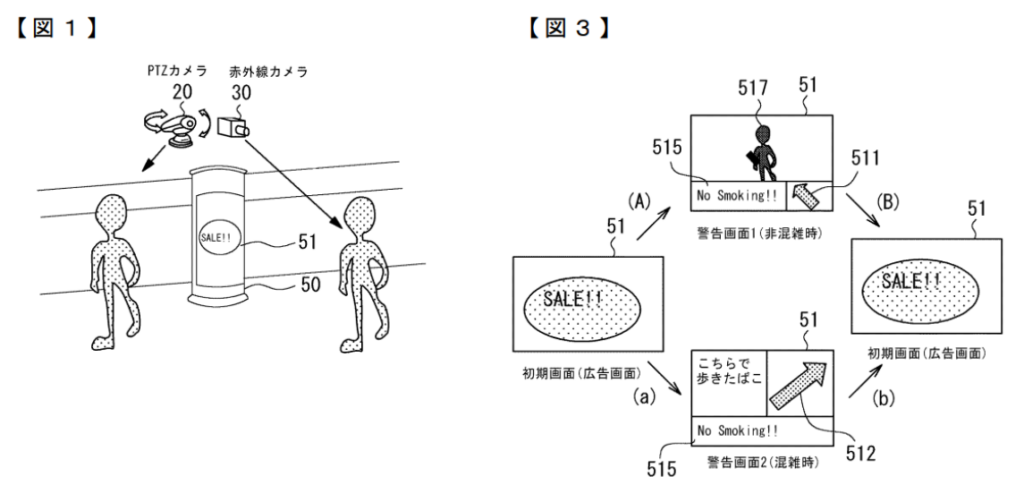
- Overview of the Patent Drawing
- Patent Insight 1: Behavior-Based Display Adjustments
- Patent Insight 2: Multi-Camera Setup for Accurate Detection
- Patent Insight 3: Application for Crowd Management and Public Safety
- Keywords
- Patent Attorney’s Thoughts
- Application of the Technology: “Self-Management Smart Mirror Advisor”
Overview of the Patent Drawing
The illustrations depict an advertising display system that utilizes cameras and behavioral detection technology to monitor individuals in the vicinity and provide targeted warnings or advertisements. Figure 1 shows a cylindrical display unit (50) with an advertisement screen (51) and two types of cameras: a PTZ camera (20) and an infrared camera (30). These cameras are used to detect the presence and behavior of individuals. Figure 3 outlines different screen transitions based on detected behaviors, such as displaying a “No Smoking” warning (515) or returning to a default advertisement (51).
Patent Insight 1: Behavior-Based Display Adjustments
The system adjusts the content displayed on the screen (51) based on the behavior of nearby individuals, as detected by the cameras. For example, if a person is detected smoking, the system transitions from the initial advertisement display to a warning message (“No Smoking!!” 515). The behavior-based display adjustments provide an adaptive approach to public signage, potentially increasing the effectiveness of safety warnings and targeted advertising by responding to real-time situations.
Patent Insight 2: Multi-Camera Setup for Accurate Detection
The use of a PTZ camera (20) and an infrared camera (30) allows for comprehensive monitoring of the area. The PTZ camera offers flexible positioning to track movement, while the infrared camera enhances detection in low-light conditions or when tracking heat signatures. This multi-camera setup ensures that the system can accurately detect behaviors such as smoking or loitering, triggering the appropriate display changes on the advertisement screen.
Patent Insight 3: Application for Crowd Management and Public Safety
The system’s ability to detect specific behaviors and issue warnings makes it suitable for applications in crowd management and public safety. As shown in Figure 3, different messages can be displayed depending on the level of crowding or activity detected. For instance, during congested conditions, the system may provide directional guidance (512) along with warnings to promote safe movement. This adaptability helps maintain order in busy areas, such as train stations or shopping malls, while still delivering advertising content.
Keywords
advertising display, behavior detection, PTZ camera, infrared camera, public safety, adaptive signage
Patent Attorney’s Thoughts
Upon reviewing the patent drawing for the “Advertising Display System with Behavioral Detection and Warning Functionality,” I perceive new possibilities in advertising.
By detecting user behavior in real-time and providing appropriate warnings or information accordingly, advertisements could evolve from mere information providers to entities that support user safety and convenience.
For instance, if a pedestrian is looking at their smartphone while walking, an advertisement could display a warning to alert them of potential dangers, thereby helping to prevent accidents.
The widespread adoption of such technology could enable advertisements to assume a societal role, contributing to public safety and comfort.
Application of the Technology: “Self-Management Smart Mirror Advisor”
Purpose
By adapting the advertising display system with behavioral detection and warning capabilities, develop a “Self-Management Smart Mirror Advisor” for homes or offices. This device monitors user behavior through the mirror and displays targeted advertisements or advice for health management and habit improvement.
System Components
- Behavior Detection Sensors: Cameras and motion sensors around the mirror analyze user posture, expression, and movements in real time.
- Warning & Advice Generation AI: Generates health or habit-related advice or alerts (e.g., “You seem to be slouching. Please straighten your back!”) based on the detected behavior.
- Smart Display Function: Incorporates a half-mirror display that overlays ads and advice on the mirror surface.
- Customization Settings: Allows users to choose ad categories of interest (health foods, exercise gear, posture correction items) for related suggestions on the mirror.
- Notification System: Integrates with smartphones or wearables to send reminders or alarms as needed.
Operational Flow
- Mirror Activation: Upon startup, the behavioral sensors and display begin operation.
- Behavior Analysis: The sensors capture user posture and expressions, while AI processes the data.
- Ad & Advice Display: Depending on the user’s condition, suggestions like “You’re slouching—maybe try a posture belt?” appear on the mirror surface.
- Issue Warnings: If unhealthy behavior continues (e.g., being sedentary for too long), the system displays a larger warning message like “Time to stretch your legs!”
- Alerts & Integration: Sends reminders to the user’s smartphone or wearable when necessary.
- Long-Term Habit Support: Users may adopt advertised products or follow advice to achieve lasting health improvements.
This system acts as a humorous “self-improvement coach in the mirror,” playfully nudging users toward healthier daily habits.
Disclaimer: This content is an AI-generated reinterpretation based on a patent drawing.
It is provided for educational and cultural purposes only, and not as legal advice.



